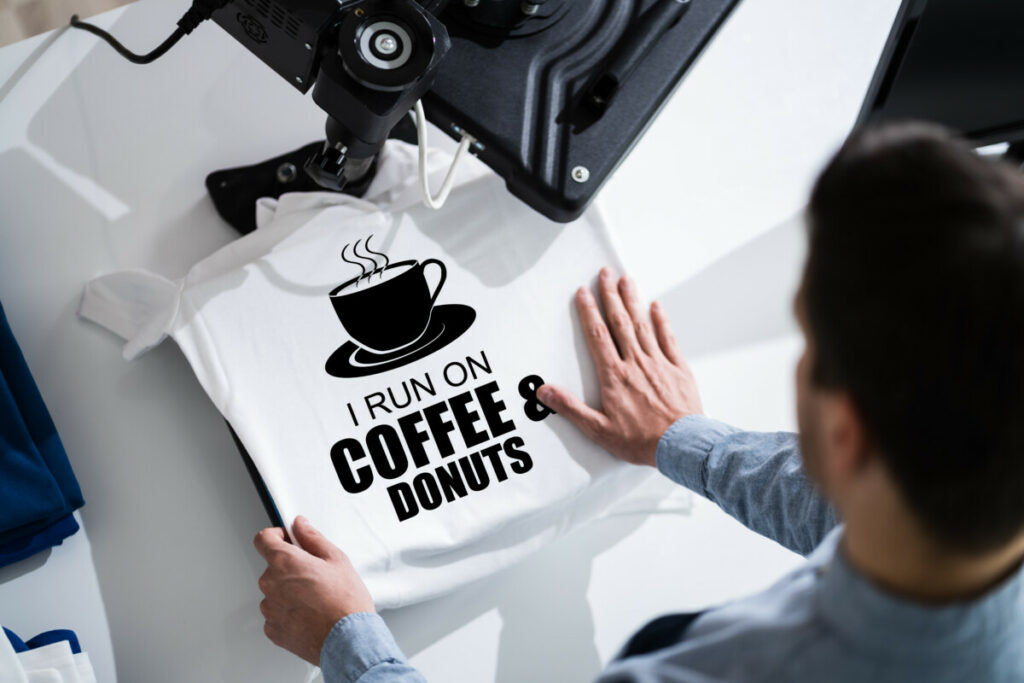
As you probably already know, print on demand is a hugely popular way to make money online.
That’s because it has two really important and attractive features.
First, it’s a low risk business because you don’t need to spend any money upfront to buy inventory and you won’t be taking on any risk of buying unused inventory during the course of operating your business because it’s essentially a “pay as you go” process.
Second, print on demand is a largely passive business model because once you have created the design for your product, you don’t need to deal with a large portion of the fulfillment, such as manufacturing the product and delivering orders – your third party suppliers handle all of that for you.
That all sounds great, but the real question is how do you get into this and what are the keys to becoming a successful print of demand operator.
In this article, I am going to cover exactly that. I will provide a detailed guide on how you can get started, including some of the key considerations you need to take into account, such as selecting the right niche, creating a great design, finding the right platform and fulfillment vendor, and using appropriate marketing strategies to grow your business.
My goal is to walk you through how to make your print on demand business easy to run and highly profitable. In a nutshell, the key to succeeding in print on demand is as follows:
Every print-on-demand business needs a design that appeals to customers and a supplier that can create and print. The business owner must evaluate, budget, and market in order to profit off of their business while taking trends, their target demographic, and their specific niches into account.
I will also cover at the outset the pros and cons of running this type of business so you have a more complete picture of what’s really involved in this type of business.
This post may contain affiliate links. If you click on a link and complete a transaction, I may make a small commission at no extra cost to you.
The information contained in this post is for informational purposes only. It is not a recommendation to buy or invest, and it is not financial, investment, legal, or tax advice. You should seek the advice of a qualified professional before making any investment or other decisions relating to the topics covered by this article.
What is a Print-On-Demand Business?
A print-on-demand business takes designs and brands and prints them on different products by working with a supplier. There are many suppliers around that deal in different products and different printing styles or specifics, finding the right one for you simply requires research.
After partnering with a supplier to work out orders and exact details, you are able to sell your products on a pre-order basis that benefits both you and the consumer. This mode of business makes it much easier to sell merchandise because of the freedom it gives the creator. They do not have to deal with inventory management or the budgeting of inventory versus sales.
Pros and Cons
Pros
Ease: The setup of a print-on-demand-based business is much easier than building a business from the ground up on your own. This is because of the stability of your third-party seller. Your supplier will likely be an established business that can deal with any amount of orders coming in. All that is needed is your contribution to the design and orders and the supplier will take care of the rest.
Management: The details involving shipping, packaging, and machinery will all be taken care of for you. Packaging can be one of the most tedious parts of selling merchandise, your third-party supplier will have the manpower and organization for you and make your part much easier. Shipping labels can also be difficult to print on your own, but even the printing of these will be taken care of.
Over-stock: Many small businesses have issues with excess stock as well as a lack of stock at times. This can slow sales down and limit profits. However, when working with a third party to print your products you will only print as much as is ordered. This is because they will already have their products on hand. If you were doing this on your own you would have to order the base products yourself, and maybe have too many or too few of them for how much is ordered. Print-on-demand companies handle this problem with ease.
Cons
Profit: Because of the dealings you will have with the third party, it is likely that your profits will be limited due to the cost of goods. The third-party company will take a large percentage due to their heavy presence in the production process. This will mean you will be the one getting a pre-determined commission based on your sales. If you are outsourcing your designs this could lower your commission even more as you would be giving a portion of the sales to your artist as well.
Products: The type and style of your products will be dependent on what your third party sells and has in stock. You will also not be able to guarantee the quality of these items. Make sure you research your supplier thoroughly so you know what to expect and what to sell. Your products will be limited to your company’s choices, so make sure you know what type of options you want to have and choose a supplier that makes the products you want.
Time: Your products will always be produced and sent out based on the timetable the supplier has. Orders will take longer to fulfill due to the “on-demand” aspect. They will be created when the order is put in and so there will be no back stock to pull from. This means it takes a lot longer between ordering and delivery, which can be frustrating for customers.
Getting Started

Select Your Niche
Sometimes when people start using print-on-demand services because they already have a following that will buy their products. This is usually for people who have become popular online and sell merchandise based on their content. These content creators often start their businesses on Instagram, TikTok, and YouTube.
However, it is possible to create relevant and desirable content and products that will sell. To do this without a following already built around you you should focus on developing your niche. This will help you find a group of people that will want to buy your prints.
Target Demographic
In order to decide what type of product, design, and price you will have, you have to decide who you are selling to. Teenagers and young adults will be interested in different things than older adults such as beanies or cell phone cases. On the opposite side, extremely niche t-shirts will be popular with an older generation of buyers.
This also makes your content feel more personalized even if you are not working with a fan base. This is also where cross-niches come in.
A cross niche is when you choose a very specified audience to cater to, such as making a shirt with a joke about reading and dogs. This caters to dog owners who like to read, therefore narrowing your target demographic but also making it more personalized.
Choosing Products
Choosing your products ties strongly into choosing your vendor as well, but this is about choosing which products will benefit your business most. When thinking about your products you will also want to focus on your target demographic as mentioned above. Younger people will be more interested in stickers and trending clothing items such as beanies and large sweatshirts.
These will also have some overlap with things that will trend for older customers such as t-shirts and long-sleeved shirts. In order to maximize sales, try to make sure you have enough product types to cater to each. T-shirts are always popular as well as cheap to make. This means they are the most optimal product to sell based on their reach and cost.
Create Your Design
Creating your design is one of the most fun, as well as most critical parts of this business. You must make designs that not only look good, but draw your customers in.
If you are an artist and getting your designs into the world is your only concern, this is fine, you know how to work with designs and colors and are likely well on your way to a great design. However, if you do not have the digital skills necessary for this process, it is possible, and recommended, that you outsource your art.
It is great if you personally know artists that could help you with your designs however, this is not always the case. If you need someone capable, but have no connections, Fiverr is a great tool. Fiverr is a website that allows creators to sell their services, and lets people find and purchase their work.
The site has professionals with many different price ranges and skill levels, as well as plenty of different skills. Some on Fiverr are good at digital design, some are proficient at color theory, and some are best for all of the above. If needing to outsource your designs, Fiverr can help you find those best suited for you and your job.
Choosing a Platform
The next question you have to ask is where you will open your online storefront. This storefront can be with your supplier, but it can and will often be with your supplier. However, it is important to establish a localized and popular place where customers can find you.
It is also possible for you to have your supplier send the finished goods to your house and you can sell the through your own platform of choice. Some of the best platforms for this are Etsy, Teespring, Merch by Amazon, Redbubble, and Instagram. Some of these will also print your products so make sure you are aware of the services they provide.
A popular choice is Etsy because of its reputation for high end custom products and generally higher price points (which often translates to higher profit margins). If you want to learn more about how to make money Etsy without making anything, check out my full article on the topic here.
Choosing a Vendor
Some of the best third-party companies are Printful, Printify, Gelato, SPOD, and Teelaunch, though each comes with its own pros and cons. In general, what you will most want to look for is quality, amount of products, and print choices, as well as the speed of shipping and ease of use.
Printful is a fast and efficient company that has products ready in up to five business days. Its shipping starts at $3.99 in the US and ships fast as well. It offers multiple different printing options including embroidery, cut and sew, and direct-to-garment.
Printful offers one of the most integrations with marketplaces including Shopify and other platforms. They offer Shirts, different pants, bags, phone cases, bean bag chairs, posters, and over 220 more products you can print on.
Printify partners all around the world to deliver and print depending on the print provider you choose. It offers many of the same printing styles and can change these styles depending on the different printers you pick. Since it is a company that matches you to a different printer it can print on about 250 total product options and allows for some of the most customizations.
Gelato offers products such as apparel, wall art, mugs, tote bags, and stationery. It has direct to garments as well as some other different printing options for select products. It also has integrations for Shopify, WooCommerce, BigCommerce, Squarespace, and Wix.
SPOD can print within 48 hours from the US at $3.57 with arrival in three to eight days. There is digital direct. thermal sublimation, digital laser transfer, and special flex printing offered with SPOD as well as its speed. It, however, does not have the largest product selection, offering T-shirts, organic t-shirts, aprons, caps, and about 100 more options.
Teelaunch is one of the top print on demand companies due to its quality. It offers direct to garment as well as cut to sew all-over-print for apparel, and laser etching for hard products. Its products range anywhere from balloons, jewelry, shoes, speakers, and journals, to t-shirts, pants, and backpacks.
Create Your Business Plan

How to Profit
In order to profit off of your merchandise, it is important to build your brand. Make sure you have a strong enough community that will buy your products. While this is needed, it is also true that due to the nature of print-on-demand businesses, there is no risk of loss associated with investing in more than you sell.
However, in order to make sure you sell it is best to follow the instructions above including building your fanbase and interest in your product as well as catering to the correct target demographic with the correct niche.
Market and Promote
As stated, it is important to build your brand in order to gain customers. The best places to do so are online on Instagram, Twitter, Tiktok, and Facebook. These places also allow you to choose your customer base well.
If you market and promote your products on Instagram and Facebook, it is more likely that you will garner the attention of an older user base. While if you focus on TikTok and Twitter, you will likely encounter more younger people. This is important to know so that you can mix your choice of promoting platform with your choice of product, niche, and demographic.
It is worth mentioning, however, that word of mouth is always the best advertising tool. Consider offering a discount code to a few friends on the condition that they tell their friends about your shop and products!
Print on demand is a growing business that can help any creator get on their feet with selling products based on their content or with their content on them. It is important to monopolize on when these products are most wanted as well, which is another reason the fast nature of print on demand is a great and easy business to get into.
Related Reading: If you want to learn more about some of the nuts and bolts of starting a business in general, including more details around setting up your business entity, website, business plan and more, check out my ultimate guide to starting a business.
Conclusion
So there you have it – a detailed guide on how to start a print on demand business, with some great resources you can use to get started right away. If you want to learn about more great passive income ideas, check out my ultimate guide to passive income, which covers more than 25 strategies that you can explore.

